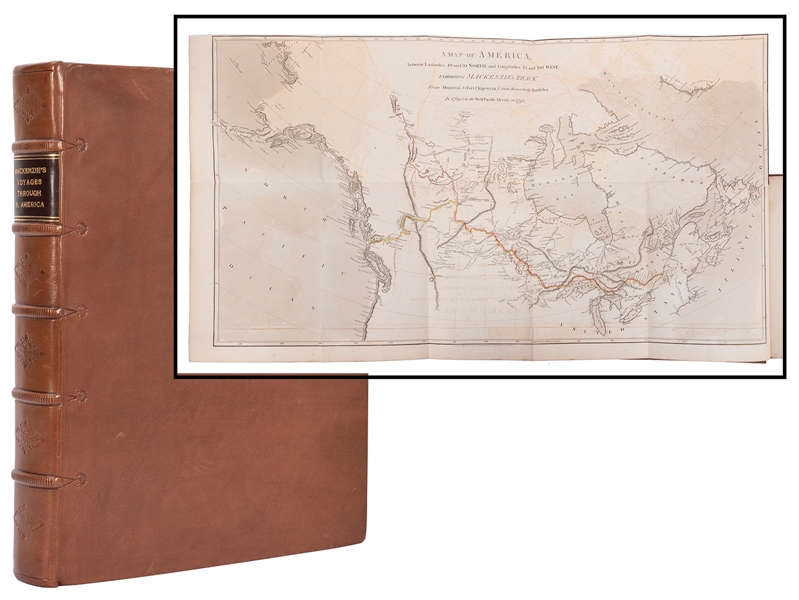MACKENZIE, Alexander, Sir (1764-1820). Voyages from Montreal, on the River St. Laurence through the Continent of North America, to the Frozen and Pacific Oceans; In the Years 1789 and 1793. With a preliminary account of the Rise, Progress, and Present State of the Fur Trade of that Country. London: T. Cadell, W. Davies, Cobbett and Morgan, and W. Creech, 1801.
MACKENZIE, Alexander, Sir (1764-1820). Voyages from Montreal, on the River St. Laurence through the Continent of North America, to the Frozen and Pacific Oceans; In the Years 1789 and 1793. With a preliminary account of the Rise, Progress, and Present State of the Fur Trade of that Country. London: T. Cadell, W. Davies, Cobbett and Morgan, and W. Creech, 1801. 4 o (271 x 211 mm). Half-title and errata leaf. Engraved portrait frontispiece and 3 engraved folding maps (one with outline coloring). (some offsetting, a few short tears to maps.) Later quarter calf (rebacked, upper cover detached). FIRST EDITION. Mackenzie, a Scotch-born fur trader, emigrated to North America in 1779 and was employed by the North West Company, a rival of the Hudson's Bay Company. In what is now the province of Alberta, Mackenzie and a cousin set up a trading post, Fort Chepewyan, on Lake Athabasca (1788). This was the starting point of his expedition of 1789. The route followed the Mackenzie River from the Great Slave Lake to the river's delta on the Arctic Ocean. Mackenzie crossed the Rocky Mountains in 1793 from Fort Chipewyan to the Pacific coast of what is now British Columbia. These journeys together constitute the first known transcontinental crossing of America north of Mexico. The work has further importance ethnographically, as it contains vocabularies of the Knisteneaux, Algonquin, Chepewyan, Hegailer and Atnah Indian languages. After expeditiously returning to Montreal after the voyage, Mackenzie sailed for England to be entertained as a colonial hero. His Voyages, written with the aid of a ghostwriter named William Combe, became an instant bestseller (see Peter C. Newman, Empire of the Bay , p. 329). "No writer upon the subject of Indian customs and peculiarities, has given us a more minute, careful and interesting relation of them, as indeed none were better fitted to do, by long experience among them. His investigations...were remarkable for their accuracy; Sir John Franklin more than once expressing his surprise at being able to corroborate their correctness" (Field 967). Graff 2630; Hill 1063 ("This is the first and finest edition of one of the most important of Canadian books."); Lande 1317; NMM 810; Peel 25; Pilling 2384; Sabin 43414; Staton & Tremaine/TPL 658; Streeter VI:3653; Wagner-Camp-Becker 1:1; Wheat Mapping the Transmississippi West 251.
MACKENZIE, Alexander, Sir (1764-1820). Voyages from Montreal, on the River St. Laurence through the Continent of North America, to the Frozen and Pacific Oceans; In the Years 1789 and 1793. With a preliminary account of the Rise, Progress, and Present State of the Fur Trade of that Country. London: T. Cadell, W. Davies, Cobbett and Morgan, and W. Creech, 1801.
MACKENZIE, Alexander, Sir (1764-1820). Voyages from Montreal, on the River St. Laurence through the Continent of North America, to the Frozen and Pacific Oceans; In the Years 1789 and 1793. With a preliminary account of the Rise, Progress, and Present State of the Fur Trade of that Country. London: T. Cadell, W. Davies, Cobbett and Morgan, and W. Creech, 1801. 4 o (271 x 211 mm). Half-title and errata leaf. Engraved portrait frontispiece and 3 engraved folding maps (one with outline coloring). (some offsetting, a few short tears to maps.) Later quarter calf (rebacked, upper cover detached). FIRST EDITION. Mackenzie, a Scotch-born fur trader, emigrated to North America in 1779 and was employed by the North West Company, a rival of the Hudson's Bay Company. In what is now the province of Alberta, Mackenzie and a cousin set up a trading post, Fort Chepewyan, on Lake Athabasca (1788). This was the starting point of his expedition of 1789. The route followed the Mackenzie River from the Great Slave Lake to the river's delta on the Arctic Ocean. Mackenzie crossed the Rocky Mountains in 1793 from Fort Chipewyan to the Pacific coast of what is now British Columbia. These journeys together constitute the first known transcontinental crossing of America north of Mexico. The work has further importance ethnographically, as it contains vocabularies of the Knisteneaux, Algonquin, Chepewyan, Hegailer and Atnah Indian languages. After expeditiously returning to Montreal after the voyage, Mackenzie sailed for England to be entertained as a colonial hero. His Voyages, written with the aid of a ghostwriter named William Combe, became an instant bestseller (see Peter C. Newman, Empire of the Bay , p. 329). "No writer upon the subject of Indian customs and peculiarities, has given us a more minute, careful and interesting relation of them, as indeed none were better fitted to do, by long experience among them. His investigations...were remarkable for their accuracy; Sir John Franklin more than once expressing his surprise at being able to corroborate their correctness" (Field 967). Graff 2630; Hill 1063 ("This is the first and finest edition of one of the most important of Canadian books."); Lande 1317; NMM 810; Peel 25; Pilling 2384; Sabin 43414; Staton & Tremaine/TPL 658; Streeter VI:3653; Wagner-Camp-Becker 1:1; Wheat Mapping the Transmississippi West 251.















Testen Sie LotSearch und seine Premium-Features 7 Tage - ohne Kosten!
Lassen Sie sich automatisch über neue Objekte in kommenden Auktionen benachrichtigen.
Suchauftrag anlegen